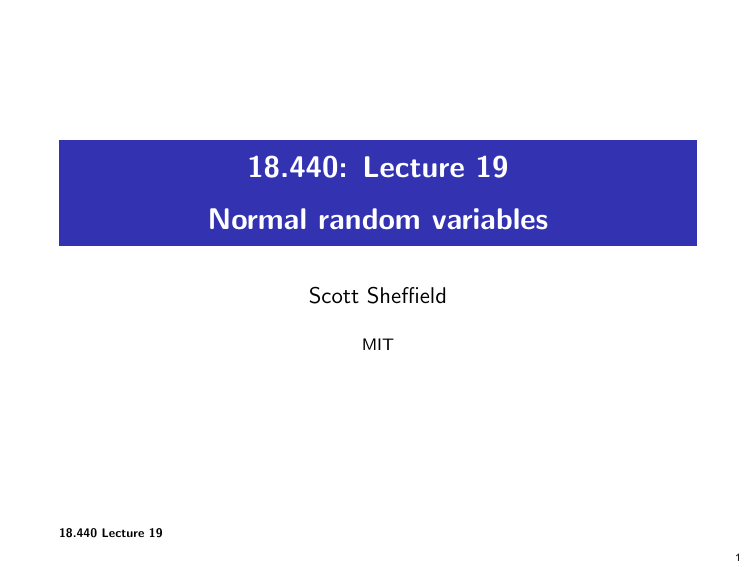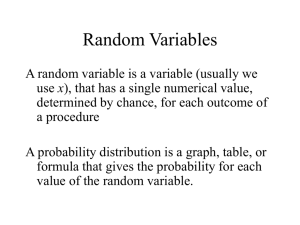Document 13434481
advertisement

18.440: Lecture 19
Normal random variables
Scott Sheffield
MIT
18.440 Lecture 19
1
Outline
Tossing coins
Normal random variables
Special case of central limit theorem
18.440 Lecture 19
2
Outline
Tossing coins
Normal random variables
Special case of central limit theorem
18.440 Lecture 19
3
Tossing coins
�
Suppose we toss a million fair coins. How many heads will we
get?
�
About half a million, yes, but how close to that? Will we be
off by 10 or 1000 or 100,000?
�
How can we describe the error?
�
Let’s try this out.
18.440 Lecture 19
4
Tossing coins
�
I
Toss n coins. What is probability to see k heads?
�
I
Answer: 2−k
�
I
Let’s plot this for a few values of n.
�
I
Seems to look like it’s converging to a curve.
�
I
If we replace fair coin with p coin, what’s probability to see k
heads.
�
I
Answer: p k (1 − p)n−k
�
I
Let’s plot this for p = 2/3 and some values of n.
�
I
What does limit shape seem to be?
n
k
.
n
k
.
18.440 Lecture 19
5
Outline
Tossing coins
Normal random variables
Special case of central limit theorem
18.440 Lecture 19
6
Outline
Tossing coins
Normal random variables
Special case of central limit theorem
18.440 Lecture 19
7
Standard normal random variable
�
I
�
I
�
I
�
I
�
I
Say X is a (standard) normal random variable if
2
fX (x) = f (x) = √12π e −x /2 .
Clearly f is alwayss non-negative for real values of x, but how
∞
do we show that −∞ f (x)dx = 1?
Looks kind of tricky.
s∞
2
Happens to be a nice trick. Write I = −∞ e −x /2 dx. Then
try to compute I 2 as a two dimensional integral.
That is, write
∞
I2 =
e −x
2 /2
∞
dx
−∞
�
I
e −y
2 /2
∞
∞
−∞
−∞
dy =
−∞
e −x
2 /2
dxe −y
2 /2
dy .
Then switch to polar coordinates.
∞
2π
I2 =
0
0
√
so I = 2π.
18.440 Lecture 19
e −r
2 /2
∞
rdθdr = 2π
0
re −r
2 /2
dr = −2πe −r
2 /2
�∞
�
� ,
0
8
Standard normal random variable mean and variance
�
I
Say X is a (standard) normal random variable if
2
f (x) = √12π e −x /2 .
�
I
Question: what are mean and variance of X ?
s∞
E [X ] = −∞ xf (x)dx. Can see by symmetry that this zero.
�
I
�
I
Or can compute directly:
Z ∞
�∞
1
1
2
2
�
√ e −x /2 xdx = √ e −x /2 �
E [X ] =
= 0.
−∞
2π
2π
−∞
�
I
How woulds we compute s
∞
Var[X ] = f (x)x 2 dx = −∞
�
I
2
√1 e −x /2 x 2 dx?
2π
2
Try integration by parts with u = x� and dv = xe −x /2 dx.
s∞
2
2
�∞
Find that Var[X ] = √12π (−xe −x /2 �
+ −∞ e −x /2 dx) = 1.
−∞
18.440 Lecture 19
9
General normal random variables
�
I
Again, X is a (standard) normal random variable if
2
f (x) = √12π e −x /2 .
I
�
What about Y = σX + µ? Can we “stretch out” and
“translate” the normal distribution (as we did last lecture for
the uniform distribution)?
�
I
Say Y is normal with parameters µ and σ 2 if
2
2
1
f (x) = √2πσ
e −(x−µ) /2σ .
I
�
What are the mean and variance of Y ?
�
I
E [Y ] = E [X ] + µ = µ and Var[Y ] = σ 2 Var[X ] = σ 2 .
18.440 Lecture 19
10
Cumulative distribution function
�
I
Again, X is a standard normal random variable if
2
f (x) = √12π e −x /2 .
�
I
What is the cumulative distribution function?
sa
2
Write this as FX (a) = P{X ≤ a} = √12π −∞ e −x /2 dx.
�
I
�
I
How can we compute this integral explicitly?
�
I
Can’t. Let’s sjust give it a name. Write
2
a
Φ(a) = √12π −∞ e −x /2 dx.
�
I
Values: Φ(−3) ≈ .0013, Φ(−2) ≈ .023 and Φ(−1) ≈ .159.
�
I
Rough rule of thumb: “two thirds of time within one SD of
mean, 95 percent of time within 2 SDs of mean.”
18.440 Lecture 19
11
Outline
Tossing coins
Normal random variables
Special case of central limit theorem
18.440 Lecture 19
12
Outline
Tossing coins
Normal random variables
Special case of central limit theorem
18.440 Lecture 19
13
DeMoivre-Laplace Limit Theorem
�
I
Let Sn be number of heads in n tosses of a p coin.
�
I
What’s the standard deviation of Sn ?
√
Answer: npq (where q = 1 − p).
�
I
�
I
The special quantity S√n −np
npq describes the number of standard
deviations that Sn is above or below its mean.
�
I
What’s the mean and variance of this special quantity? Is it
roughly normal?
�
I
DeMoivre-Laplace limit theorem (special case of central
limit theorem):
Sn − np
lim P{a ≤ √
≤ b} → Φ(b) − Φ(a).
npq
n→∞
�
I
This is Φ(b) − Φ(a) = P{a ≤ X ≤ b} when X is a standard
normal random variable.
18.440 Lecture 19
14
Problems
�
I
�
I
Toss a million fair coins. Approximate the probability that I
get more than 501, 000 heads.
√
√
Answer: well, npq = 106 × .5 × .5 = 500. So we’re asking
for probability to be over two SDs above mean. This is
approximately 1 − Φ(2) = Φ(−2) ≈ .159.
�
I
Roll 60000 dice. Expect to see 10000 sixes. What’s the
probability to see more than 9800?
√
Here npq = 60000 ×
16 ×
56 ≈ 91.28.
�
I
And 200/91.28 ≈ 2.19. Answer is about 1 − Φ(−2.19).
I
�
18.440 Lecture 19
15
MIT OpenCourseWare
http://ocw.mit.edu
18.440 Probability and Random Variables
Spring 2014
For information about citing these materials or our Terms of Use, visit: http://ocw.mit.edu/terms.



